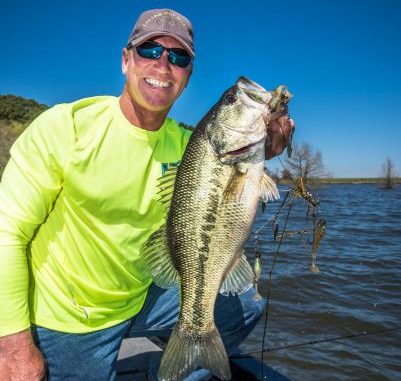
Double-digit Toledo Bend bass are turning up seemingly every day — and on some days, several fish weighing more than 10 pounds are registered at Toledo Town and Tackle in Many.
The message has gotten out: There are plenty of those huge fish swimming around.
But if you’re looking to up your odds at getting a number of bites while also catching some big fish, Jerry Thompson said the Alabama rig is the way to go right now.
“When I saw some shad schooling up and spawning (recently), I knew it was time to throw the A-rig,” the owner of Living the Dream Guide Service said.
Thompson said the key to success is to work the rig in a way that realistically mimics schools of the baitfish.
“You cast it out and reel it,” he said. “But if you’ve ever seen how schools of shad swim, they swim and flutter and stop, and then they they’ll take off again. You want to reel it along slowly, slow down some, stop and then start reeling again.”
LTD guide Matt Loetcsher said that, while most people tend to think the A-rig as an open-water tactic because of the exposed hooks on the multiple jig, it’s a mistake to avoid that cover.
“Don’t be scared to throw it around grass,” Loetchser said. “When you catch big fish, they’re going to be around some kind of cover — that’s just how big fish operate.
“They’re not going to be just anywhere.”
Thompson agreed, saying he usually focuses around hay grass and flooded timber in 5 to 8 feet of water. But the real determining factor is the shad.
“If the shad are up in the hay grass spawning, that’s where I fish,” Thompson said. “Stay where the shad are.”
Novices to the Alabama rig (also called an umbrella rig) can get intimidated by the bulky spread of baits and work themselves to death trying to cast it, but Thompson said that’s because these anglers are working way too hard.
“Once you learn to leverage it, it’s not too bad,” Thompson said. “You’re just kind of flipping it out there; you not rearing back and throwing it.
“Let the lure do the work.”
Of course, it’s also important to use the proper rig — meaning a rod that can handle the heavy A-rigs. For instance, the rig being used when the author fished with Thompson this week included a total of about 2 ounces of lead on five jigs and a main weight, and it was a “junior” model.
His rig had five 1/4-ounce jigheads built on 2/0 hooks. But other models are much, much heavier.
“Picasso makes one that has 16 baits on it, which I much prefer because the more baits you throw the more bites you get,” Thompson said.
Loetscher said Storm swim baits are the perfect matches to the jigs to bring the spread to life.
“Those Storm swim baits are about perfect,” he said. “When they came out, nobody paid much attention because they weren’t good for much, and then the A-rig came out and it was, like, ‘Whoa, they’re perfect.’
“And they last a long time, so you can catch a lot of fish on them before having to change them out.”
Willow-leaf spinners are added to the arms just above the jigs to add flash, which only heightens the appearance of a group of shad swimming through the water.
To handle these hefty spreads, the guide service’s rod of choice is a 7-foot, 10-inch heavy-action Irod Bama Rig Special that has plenty of spine with just enough tip to help load the rod and catapult the rig out.
That stiff backbone — no matter which rod you use — is vital characteristic.
“You will break a lesser rod,” Thompson said.
Loetscher said he matches the Irod with a 7:1 reel.
Line is a matter of preference, with many anglers using braid.
“I personally prefer fluorocarbon, because I get more bites off it,” he explained. “You need to throw no less than 20-pound fluorocarbon. But I have to cut and retie a lot, because it gets wrapped around (the A-rig).”
It’s important to understand how to set the hook on a bass. Or rather, how to allow the bass to hook themselves.
“When you feel a fish hit it, you just keep reeling,” Loetscher said. “A lot of times they’re just trying to kill it, so they’ll hit it and then come back to it.
“You just let the rod load up, and then you set the hook.”
It’s important to have your reel’s drag set to allow big fish to pull some line out: The author lost a nice fish because his reel’s drag, which was initially set for punching grass, was locked down.
“A fish will pull off, so you have to have some drag, Loetscher said.
While the Alabama rig will definitely put up your catch rate when around schools, Thompson said it’s a limited-time offer, usually ending by late May.
“Once the (bass) go into post-spawn you can put this thing up for the year,” he said. “Once the fish move out and the shad quit spawning, you can forget it — unless you find schooling fish. Then you can throw it out amongst (the feeding bass); I think they compete with each other.”
Editor’s note: Living the Dream Guide Service can be reached at 318-990-9156 or 318-256-8991.


